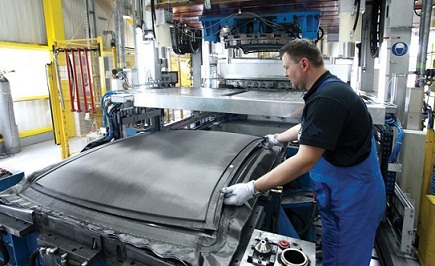Nano-structured carbon interfaces are highlighted on World Economic Forum's Global Agenda Council on Emerging Technologies list as a promising new technology. Carbon fibres are nothing new. We have these kinds of composite materials everywhere - in airplanes also in military hardware. For example, Airbus A350 XWB is built of more than 50 percent carbon-fibre reinforced polymer. Thing which is really exciting about this technology is two-fold.

First- fibre is becoming cheaper and we are learning how to better integrate carbon fibres in a resin, which will produce polymer which creates matrix to be able to shape anything we wish for which is critically important because it allows you to create a fabric, a textile from your fibres. That fabric is embedded into a resin which is a liquid which is very easy to mould into any kind of shape. From manufacturing point of view this is very easy. Main problem was cost until quite recently but which is going down.
Second- main breakthrough which we are highlighting in this year's list is possibility of creating anchoring sites for polymer on surface of carbon fibre. By engineering such cleavable "release points" into material, it is easier to decouple polymer and fibre for recycling. Difficulty of recycling these materials was one of main obstacles to this technology, so this is a significant breakthrough.
What kind of uses can this technology be put towards?
Transportation is main hope for two reasons: lighter cars, which will save energy; and materials with better mechanical properties, which will improve safety. These materials are not stronger because y are harder, but because y can absorb impact. Which is exactly kind of protection you which want to get when you are driving? You want more flexible material which can absorb impact, as in a bullet-proof vest.
Today's cars have lots of void spaces to make m light, but which is not very good for safety. These carbon fibre-containing polymers can be incorporated into all void spaces within car for added protection. In future, they can fully replace parts car's bodywork, as it already happens in high-end automobile racing cars, making m lighter (and therefore more fuel-efficient) and equipped to absorb impacts.
What is function of carbon fibres in these new composite materials?
This idea is to prevent cracks forming and spreading. Imagine you've a piece of plastic. It might be cracked easily. But if you have a network of fibres inside it, it's going to be very difficult to break because which network of fibres is creating a structure within plastic, which will make it almost impossible to break which piece. That is idea behind shields, for example, and reason carbon fibre-reinforced polymers are already used in high-end sports equipment like bicycle frames, racquets and rowing shells.
What stage of development is this technology at moment? How soon is it going to come to market?
This is a complicated question because carbon fibre-reinforced polymer technology is already at commercial scale, but at a very high cost. We decided to highlight nanostructuring of carbon fibres as one of our top 10 emerging technologies because incorporation of cleavable "release points" on carbon surface can help to separate carbon from polymer phase, making its recycling possible and significantly reducing its overall cost.
For example, when your car is at end of its life, you take it back to producer. There, car is dissembled into different parts and many of m is reused. If carbon fibre-reinforced polymers could be also reused, this could reduce its cost and create a new industry to recycle se types of cars. It potentially could be a very profitable business and could help reduce cost of cars, while increasing their safety and fuel efficiency. There are some pilot scale experiments, but it's still not at commercial scale. US Department of Energy says which reducing a car's weight by only 10 percent can improve fuel efficiency by 6 to 8 percent which is also a major incentive in a time of increasing fuel prices. Also, many people will be ready to pay extra for a safer car.
What kind of timescale are we talking about before cost comes down to a reasonable level?
Making this kind of prediction is always difficult, but I would say which idea of anchoring sites is ready to be deployed in five to seven years. chemistry behind this technology has been well known for a long time. I don't see any major technical main obstacles there. Main challenge is to create recycling industry which will allow for competitive prices and large-scale production.
Is re an element of a chicken and egg problem here, in which you need recycling industry around it to make it viable, but you need se products coming on to market in sufficient volume for recycling industry to develop?

Which has been problem until now? Technology which we highlight this year makes recycling easier and should catalyse formulation of this recycling industry which has not been possible before because it has been really difficult to separate carbon from plastic. Nowadays, when very expensive car, aircraft or sport equipment containing carbon-based composites is dismantled, pieces are not recycled. y are not recovered because there is not enough volume and also because we don't have right technology. Engineered cleavable release points on carbon should make recycling easier and could create business opportunity to fill which gap.
Is it an opportunity which major car manufacturers are ready to take up?
What they're looking for is for niche market opportunities like electric car, which is still expensive but some people are willing to pay for it. Then there are sport cars. There are different niche opportunities for people which want really fast, light, energy-saving kinds of cars. car industry is extremely good at marketing different types of car for different types of clients. Carbon-based composites allow for really light, high-speed cars with wonderful design. Because carbon fibres are embedded in a mouldable resin which is later hardened, you can shape this kind of composite as you wish, allowing for complex and really unusual designs. Regarding fuel efficiency, most attention has been paid to engine, producing significant improvement. Using lighter materials for car making opens new opportunities.
One of problems with electric cars so far has been battery not being able to store enough energy to get sufficient range for car. Using carbon-based composites should help with this because it would produce a lighter car and so battery would need to store less energy, right?
Absolutely, for environmentally conscious people, getting lighter cars makes sense. Lighter vehicles not only require less energy, but also allow for reducing overall weight of car, which is especially important when using multiple rather heavy batteries. In race for smaller, lighter batteries, reducing overall weight of vehicle by using carbon-based composites could make a real difference.
Are re any or industry areas where this kind of technology will be beneficial which perhaps haven't been able to adopt it before?
Aviation and military are very important markets for carbon-based composites because of increasing need for materials with excellent strength/weight ratio. Their appetite for this kind of technology is only going to grow.
Are we talking about a couple of decades before this technology becomes mainstream?
Yes, but a shorter time scale for niche applications. Sports car people, people who would be willing to pay a lot of money for best kind of cars, could be champions we need to take this technology to next level. They're always looking for newest materials, newest edge, and newest technology. Or it could be for people concerned for environment and to enable electric cars to flourish. It might be a mixture. It's going to mainstream anytime soon. Important thing is which now we have technology which makes carbon-composite recycling possible.